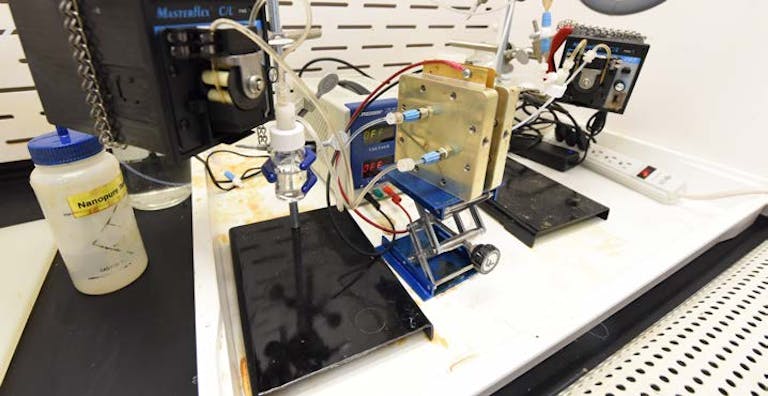INL News Release
FOR IMMEDIATE RELEASE
Oct. 6, 2020
NEWS MEDIA CONTACTS:
Leslie Wright, 208-709-2044, [email protected]
Sarah Neumann, 208-520-1651, [email protected]
Three Idaho National Laboratory technologies have won R&D 100 Awards in 2020.
Since their inception in 1963, the R&D 100 Awards have celebrated research and development technologies from across the public and private sectors and are a prestigious distinction for inventors. Laboratories and companies across the nation submit nominations, and a panel of more than 40 industry-leading experts ranks the entries based on technical significance, uniqueness, and applicability across industry, government and academia. Typically, the U.S. Department of Energy’s national laboratories have dozens of finalists every year.
Including this year’s winners, INL has won 25 R&D 100 Awards since 2005.
This year, due to concerns with the COVID-19 pandemic, the 2020 R&D 100 Awards ceremony was held virtually.
WINNING TECHNOLOGIES LED BY INL:
Carbon CURE (Carbon Capture & Utilization through Reduction Electrolysis)
Researchers: Luis Diaz Aldana (principal investigator), Ningshengjie Gao, Tedd Lister, Birendra Adhikari, Aaron Wilson, Eric Dufek

Description: Decarbonizing energy production through carbon capture and sequestration (CCS) is a popular idea that has been plagued by operational and economic challenges, but integrating carbon capture with reuse to make high-value products could offer an operational advantage. The Carbon CURE process provides a solution by using recyclable solvents as a carbon capture medium that can be fed directly to an electrochemical cell. The cell converts carbon dioxide to syngas, the building block for a raft of high value products. The process will help to achieve economical carbon capture at an industrial scale.
CoDeAc (Colorimetric Detection of Actinides)
Researchers: Catherine Riddle (principal investigator), Rick Demmer

Description: In responding to an accident or attack, handheld detectors may provide adequate screening for some radiation sources but they lack the sensitivity to detect alpha emitters such as uranium and plutonium in dusty, outdoor environments. CoDeAc can help responders quickly detect actinides at any disaster or accident scene. CoDeAc’s color change in the presence of very low concentrations of uranium and plutonium gives a go/no-go result in seconds, allowing these professionals to make decisions based on actual data instead of assumptions on-site. These decisions impact everyone and can mean the difference between evacuating hundreds of thousands of people within square miles or just 100 people within a square block during a radiological event.
Crop Artificial Intelligence Quotient (Crop AIQ)
Researchers: Mike Griffel (principal investigator), Damon Hartley (biomass analysis), M. Ross Kunz (data analytics)
Description: Crop AIQ provides a vital function: agricultural performance assessments that allow land managers to make more informed decisions about how they grow plants for food, feed, fiber and fuel. The tool gives farmers the ability to generate an accurate yield map without having to rely on harvester data, the only other way to produce such a map. A yield map is fundamental to precision agriculture and integrated land management. It is also basic to maximizing agriculture productivity and profitability, while minimizing environmental impact.
FINALIST TECHNOLOGIES LED BY INL:
CellSage-KTA (Kinetic & Transient Analyses)
Researcher: Kevin Gering
Description: CellSage-KTA is an advanced computational tool that gives insight into a battery cell’s age. It employs physics, electrochemistry and thermodynamics to diagnose battery health in real time on a standard personal computer or laptop. It also can be used to predict battery performance and track aging characteristics through multiple mechanisms.
High-Moisture Pelleting Process
Researcher: Jaya Shankar Tumuluru
Description: High-Moisture Pelleting Process helps produce biofuels and biopolymers for roughly 60% less compared to the cost of current practices, making these bioproducts cost-competitive with petroleum-based alternatives. The method efficiently dries and pellets high-moisture biomass, significantly reducing energy consumption for preprocessing materials such as agriculture leftovers or municipal solid waste.
OpDefender
Researchers: Briam Johnson (principal investigator), Michael McCarty, Rishi Chatterjee, Kristopher Watts (Gravwell Group)
Description: The OpDefender, an intelligent software-defined networking switch, protects electric utilities, oil and gas infrastructure, water systems, and other critical infrastructure from cyberattack. OpDefender uniquely monitors and protects industrial control systems at the application protocol layers, reducing the cyberattack surface by as much as 99% compared to standard industrial switches.
Route Operable Unmanned Navigation of Drones (ROUNDS)
Researchers: Ahmad Al Rashdan (principal investigator), Michael L. Wheeler, Dakota Roberson (University of Idaho), Roger Lew (University of Idaho)

Description: ROUNDS is a cost-effective method for drones to navigate a course inside a building or structure where a strong GPS signal is absent. Self-navigation is achieved by determining the drone’s location from the visual angle of QR codes placed along a desired course, then dynamically adjusting trajectory accordingly. Self-navigating drones using ROUNDS could gather instrument data, check inventory, perform security rounds or do other tedious tasks, saving time and money while increasing operational efficiency across a range of industries. Likewise, automated movement of drones could improve safety by eliminating the need for people to enter areas that are hazardous due to elevation or the presence of chemicals or radiation.







